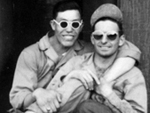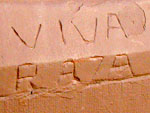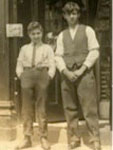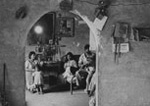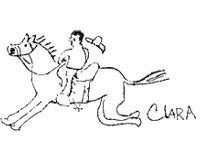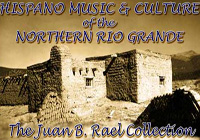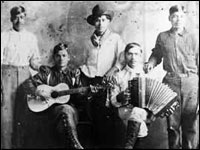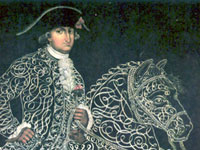A funny—or not so funny—thing happened on the way to making what was conceived as a historically complex version of the Alamo's story: 9/11. Though the Walt Disney Company had agreed to make The Alamo at least two years before the World Trade Center fell, the film was reconceived in the year after that event. By the summer of 2002, The Alamo had lost its director (Ron Howard) and its star (Russell Crowe), and the screenplay by John Sayles was undergoing a major rewrite. Howard was replaced by John Lee Hancock, Crowe was replaced by Dennis Quaid, and Sayles's screenplay was rewritten by a team of script doctors. The 2004 release of The Alamo culminated what had been a long and public struggle to make this film.
Howard's expressed interest was based on his desire to correct the historical inaccuracies found in the John Wayne-directed The Alamo (1960), a creature of the Cold War and Wayne's rightist politics. In addition, Howard was intrigued by the complexities of ethnic conflict and the issues of U.S. expansion that the Alamo story presented. Said Howard upon leaving the project, “I realized that there was a disconnect between the studio and I as to how the film should be approached.” The completed version of the film retains vestiges of Howard's vision, but they are largely submerged within a film that was built by committee in a post-9/11 United States.
For such myths to perform their cultural work, we must see those who died in the events as martyrs for the greater national cause.
The battle of the Alamo as a historical event, like Custer's Last Stand, the attack on Pearl Harbor, and now 9/11, stands as one of the galvanizing events in the narrative of U.S. history, providing a tale of tragic commitment to the cause of U.S. nationalism. Ideally, the story would lead to the redemptive annihilation of those who had killed these tragic heroes. Richard Slotkin's broad concept of “regeneration through violence” and his more focused discussion of the cultural significance of Custer's Last Stand in his study The Fatal Environment: The Myth of the Frontier in the Age of Industrialization, 18001890 (1985) help us see the cultural work that this film attempts to do and the way it fuses residual myth and contemporary events. For such myths to perform their cultural work, we must see those who died in the events as martyrs for the greater national cause. Apparently Howard was at least going to mitigate that mythology. The film as released embraces it, though in a somewhat diffuse way.
The Alamo begins with ground-level shots of the courtyard of the Alamo mission and the plains outside the walls that show the carnage of the siege of the mission, providing an image that triggers memories of the events of September 2001. The film then jump-cuts to a title informing us that we are now in Washington, DC, one year earlier, in 1835. We see Sam Houston (Dennis Quaid) at a ball attempting to interest investors in Texas lands and Davy Crockett (Billy Bob Thornton) somewhat sheepishly attending a play that embellishes his life and legend. In these scenes we can see the intention of Howard and his crew to demystify the legends of Houston and Crockett. Houston is primarily an entrepreneur, and one with a drinking problem, and Crockett a creature intrigued by the contours of his own legend. But in the film as made, we subsequently see how circumstances have remade these worldly men into heroes (though Thornton's Crockett is somewhat abashed by the dimensions of his own fame, a perspective that makes this Crockett a far more humble and complex figure than he was in the Disney television series of the 1950s or in the Wayne film).
But what is missing is…a sense of the way the events at the Alamo are connected to the national story of slavery, expansion, and the removal of Native Americans…
As history, The Alamo looks accurate, and, indeed, we find that San Antonio de Béxar was carefully re-created with little sparing of expense (the film cost $95 million to make) and with the able assistance of the Alamo historian and curator, Richard Bruce Winders, and Stephen L. Hardin, a historian at Victoria College in Victoria, TX. But what is missing is similar to what is absent from the Wayne movie: a sense of the way the events at the Alamo are connected to the national story of slavery, expansion, and the removal of Native Americans from the eastern United States in the 1830s and 1840s. If we include this larger tale, we can perhaps get a feel for the broader perspective that initially generated interest in the project.
Andrew Jackson's policy of removing indigenous peoples from east of the Mississippi River to the West relied on the United States' domain over those western lands. Although Texas was not a part of the land that Jackson had dedicated to the tribes displaced from the East, it did abut them. Further, Texas had become a more and more tempting piece of western land after Mexico became independent of Spain in 1821. Mexico lacked economic resources, a strong central government, and a clear sense of national identity. The relative weakness of the nation to the south made annexation of its lands quite attractive. That the Mexican government had encouraged Anglo settlement further tempted entrepreneurs and manifest destinarians alike.
Texas also rose to the center of the national consciousness as a result of its relation to the line of demarcation that defined slave and free states in the Missouri Compromise of 1820. As a state south of the southern border of Missouri, its entry into the Union would make it a slave state, and, indeed, its various settlers had mostly come from the South, some bringing slaves. The issue of slavery would remain a matter of debate both in defining the region as part of the United States and in exacerbating the conflict with Mexico over domain. And while the film does introduce the question of where the loyalties of its two characters who are enslaved should lie—with the antislavery Mexicans or the proslavery Anglos—the broader issue of slavery in Texas is largely elided.
Texas also rose to the center of the national consciousness as a result of its relation to the line of demarcation that defined slave and free states in the Missouri Compromise of 1820.
Similarly, there is a Hispanic character, Juan Seguin (Jordi Mollà), who has a secondary role in the film and whose status as a Mexican who supports the Anglos is clearly significant. But there is little fleshing out of the character or his reasons, elements that might have added historical complexity to the narrative. Historically, Seguin was a civic leader in the Béxar region who supported the independence movement in 1835 and 1836 and led a militia of around a hundred men. This placed him among a minority of Mexicans who supported the independence movement because of their opposition to federalism and support of local rule. However, by 1837 almost no non-Anglos remained loyal to the Republic of Texas, as the racist practices of its leaders and partisans had reduced all Mexicans to a subordinate political and social status.
The film ends with the redemptive Battle of San Jacinto, as the Anglo forces are led to victory by Sam Houston, thus closing our narrative. The final scene cuts from the mass killing fields of San Jacinto, featuring dead Mexican soldiers as far as the eye can see, to the iconic figure of Davy Crockett fiddling on the wall of the Alamo. The carnage at San Jacinto redresses the slaughter at the Alamo and is all the more significant for its delivering Texas from the clutches of the tyrannical Mexican general Antonio López de Santa Anna. The vanquishing of the barbaric and morally suspect—evil—Mexican leader brings into being the Texas republic. In contemporary terms, such a conclusion is oddly resonant as national leaders attempt to show how delivering Iraq from the clutches of the tyrannical Saddam Hussein—and the imposition of “democracy” in that nation—will avenge the attacks of 9/11. On March 2, 2005, Republican congressman Ted Poe from the district that includes the Alamo spelled out the connection:
On this day, 169 years ago, Texas declared its independence from Mexico and its dictator, Santa Anna, the 19th-century Saddam Hussein. . . Freedom has a cost. It always does. It always will. And as we pause to remember those who lost their lives so that Texas could be a free Nation, we cannot forget those Americans that are currently fighting in lands across the seas for the United States’ continued freedom and liberty today.
